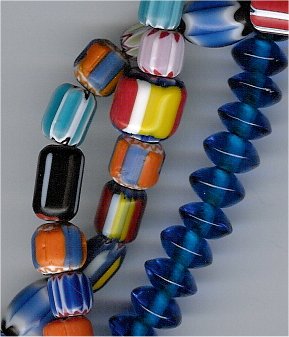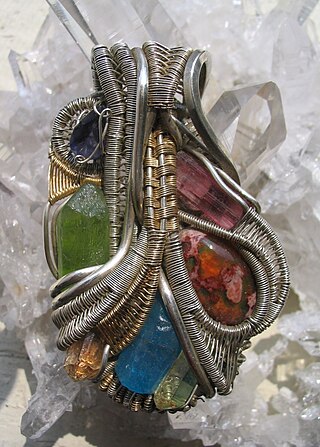
Beadwork is the art or craft of attaching beads to one another by stringing them onto a thread or thin wire with a sewing or beading needle or sewing them to cloth. Beads are produced in a diverse range of materials, shapes, and sizes, and vary by the kind of art produced. Most often, beadwork is a form of personal adornment, but it also commonly makes up other artworks.

A bead is a small, decorative object that is formed in a variety of shapes and sizes of a material such as stone, bone, shell, glass, plastic, wood, or pearl and with a small hole for threading or stringing. Beads range in size from under 1 millimeter (0.039 in) to over 1 centimeter (0.39 in) in diameter.

A pearl is a hard, glistening object produced within the soft tissue of a living shelled mollusk or another animal, such as fossil conulariids. Just like the shell of a mollusk, a pearl is composed of calcium carbonate in minute crystalline form, which has deposited in concentric layers. The ideal pearl is perfectly round and smooth, but many other shapes, known as baroque pearls, can occur. The finest quality of natural pearls have been highly valued as gemstones and objects of beauty for many centuries. Because of this, pearl has become a metaphor for something rare, fine, admirable and valuable.

Yarn is a long continuous length of interlocked fibres, used in sewing, crocheting, knitting, weaving, embroidery, ropemaking, and the production of textiles. Thread is a type of yarn intended for sewing by hand or machine. Modern manufactured sewing threads may be finished with wax or other lubricants to withstand the stresses involved in sewing. Embroidery threads are yarns specifically designed for needlework. Yarn can be made of a number of natural or synthetic materials, and comes in a variety of colors and thicknesses. Although yarn may be dyed different colours, most yarns are solid coloured with a uniform hue.

A color gel or color filter, also known as lighting gel or simply gel, is a transparent colored material that is used in theater, event production, photography, videography and cinematography to color light and for color correction. Modern gels are thin sheets of polycarbonate, polyester or other heat-resistant plastics, placed in front of a lighting fixture in the path of the beam.

Glassblowing is a glassforming technique that involves inflating molten glass into a bubble with the aid of a blowpipe. A person who blows glass is called a glassblower, glassmith, or gaffer. A lampworker manipulates glass with the use of a torch on a smaller scale, such as in producing precision laboratory glassware out of borosilicate glass.

A japamala, jaap maala, or simply mala is a loop of prayer beads commonly used in Indian religions such as Hinduism, Buddhism, Jainism and Sikhism. It is used for counting recitations (japa) of mantras, prayers or other sacred phrases. It is also worn to ward off evil, to count repetitions within some other form of sadhana such as prostrations before a holy icon. They are also used as symbols of religious identification.

Sausage casing, also known as sausage skin or simply casing, is the material that encloses the filling of a sausage. Natural casings are made from animal intestines or skin; artificial casings, introduced in the early 20th century, are made of collagen and cellulose. The material is then shaped via a continuous extrusion process—producing a single sausage casing of indefinite length—which is then cut into desired lengths, usually while the extrusion process continues.

Extrusion is a process used to create objects of a fixed cross-sectional profile by pushing material through a die of the desired cross-section. Its two main advantages over other manufacturing processes are its ability to create very complex cross-sections; and to work materials that are brittle, because the material encounters only compressive and shear stresses. It also creates excellent surface finish and gives considerable freedom of form in the design process.

Lampworking is a type of glasswork in which a torch or lamp is used to melt the glass. Once in a molten state, the glass is formed by blowing and shaping with tools and hand movements. It is also known as flameworking or torchworking, as the modern practice no longer uses oil-fueled lamps. Although lack of a precise definition for lampworking makes it difficult to determine when this technique was first developed, the earliest verifiable lampworked glass is probably a collection of beads thought to date to the fifth century BCE. Lampworking became widely practiced in Murano, Italy in the 14th century. As early as the 17th century, itinerant glassworkers demonstrated lampworking to the public. In the mid-19th century lampwork technique was extended to the production of paperweights, primarily in France, where it became a popular art form, still collected today. Lampworking differs from glassblowing in that glassblowing uses a furnace as the primary heat source, although torches are also used.

Fly tying is the process of producing an artificial fly used by fly fishing anglers to catch fish. Fly tying is a manual process done by a single individual using hand tools and a variety of natural and manmade materials that are attached to a hook. Although the recent history of fly tying dates from the middle 1800s, fly tyers were engaged in tying flies since at least 200 AD.

Prayer beads are a form of beadwork used to count the repetitions of prayers, chants, or mantras by members of various religions such as Hinduism, Buddhism, Shinto, Umbanda, Islam, Sikhism, the Baháʼí Faith, and some Christian denominations, such as the Roman Catholic Church, the Lutheran Church, the Oriental Orthodox Churches, and the Eastern Orthodox Churches. Common forms of beaded devotion include the mequteria in Oriental Orthodox Christianity, the chotki or komposkini or prayer rope in Eastern Orthodox Christianity, the Wreath of Christ in Lutheran Christianity, the Dominican rosary of the Blessed Virgin Mary in Roman Catholic Christianity, the dhikr in Islam, the japamala in Buddhism and Hinduism, and the Jaap Sahib in Sikhism.

Glass bead making has long traditions, with the oldest known beads dating over 3,000 years. Glass beads have been dated back to at least Roman times. Perhaps the earliest glass-like beads were Egyptian faience beads, a form of clay bead with a self-forming vitreous coating. Glass beads are significant in archaeology because the presence of glass beads often indicate that there was trade and that the bead making technology was being spread. In addition, the composition of the glass beads could be analyzed and help archaeologists understand the sources of the beads.

Chevron beads are special glass beads; the first specimens of this type were created by glass bead makers in Venice and Murano, Italy, toward the end of the 14th century. The first examples were invented by Marietta Barovier. They may also be referred to as rosetta, or star beads. The term rosetta first appeared in the inventory of the Barovier Glass works in Murano, in 1496, in context with beads as well as with other glass objects.

In glassblowing, cane refers to rods of glass with color; these rods can be simple, containing a single color, or they can be complex and contain strands of one or several colors in pattern. Caneworking refers to the process of making cane, and also to the use of pieces of cane, lengthwise, in the blowing process to add intricate, often spiral, patterns and stripes to vessels or other blown glass objects. Cane is also used to make murrine, thin discs cut from the cane in cross-section that are also added to blown or hot-worked objects. A particular form of murrine glasswork is millefiori, in which many murrine with a flower-like or star-shaped cross-section are included in a blown glass piece.

Peranakan cut beads are faceted glass beads used by the Peranakan women to make Peranakan beaded slippers and other Peranakan artifacts like wedding veils, handbags, belts, tapestries and pouches.

Wire wrapping is one of the oldest techniques for making handmade jewelry. This technique is done with jewelry wire and findings similar to wire to make components. Wire components are then connected to one another using mechanical techniques with no soldering or heating of the wire. Frequently, in this approach, a wire is bent into a loop or other decorative shape and then the wire is wrapped around itself to finish the wire component. This makes the loop or decorative shape permanent. The technique of wrapping wire around itself gives this craft its name of wire wrapping.

Sandblasting, sometimes known as abrasive blasting, is the operation of forcibly propelling a stream of abrasive material against a surface under high pressure to smooth a rough surface, roughen a smooth surface, shape a surface or remove surface contaminants. A pressurised fluid, typically compressed air, or a centrifugal wheel is used to propel the blasting material. The first abrasive blasting process was patented by Benjamin Chew Tilghman on 18 October 1870.

A thread is a long strand of material, often composed of several filaments or fibres, used for joining, creating or decorating textiles. Ancient Egyptians were known for creating thread using plant fibers, wool and hair. Today, thread can also be made of many different materials including but not limited to cotton, wool, flax, nylon, silk, polyester etc. There are also metal threads, which can be made of fine wire.

Thermoplastic road marking paint, also called hot melt marking paint, is a kind of powder paint. When applied as road surface markings, a hot melt kettle is used to heat it to 200 °C (392 °F) to melt the powder, after which it is sprayed on the road surface. After cooling, the paint forms a thick polymer layer, which is wear-resistant, bright, and reflective. In recent years, practical applications tests have proved that the marking lines lack surface roughness and can easily cause wheel slip, resulting in a traffic accident in snow and rainy weather. Therefore, some countries once restricted the use of this paint or demand the use of anti-skid particles. In order to increase the antiskid performance of the line, thermoplastic paint has added reflective glass beads and other coarse fillers. Thermoplastic can be used very effectively for large anti-skid areas on roads and pedestrian walkways by adding glass beads. It can be produced in any colour and is suitable for car parks, factory walkways, and many other areas. It hardens quickly and can be driven over after just a few minutes.
























